What are non-protein amino acids?
Amino acids are the building blocks of proteins or peptides comprising of carbon, hydrogen, oxygen, sulphur, nitrogen, carboxylic acid, and amino groups.
However, there are certain amino acids which are not involved in primary metabolism, and are not part of any proteinic molecule. They are known as non-protein amino acids (NPAAs).
These amino acids are not coded for by the genetic code of the DNA. 1
NPAAs can occur in nature owing to the following conditions – 2
1. Metabolic intermediates
2. Post-translational modifications
3. Components of biomolecules
4. Pharmacologic agents
5. Experimental models
Classification
Non-protein amino acids can be classified on the basis of – 3
- Functional Group
- Physiologic effects (Neurotoxic)
- Miscellaneous
Synthesis
The synthesis of a few significant NPAAs are given below –
1. Citrulline – Citrulline is one of the most important non-proteinic amino acids. It was first isolated from watermelon (“Citrullus” in Latin) after which it is named. It is naturally present in the L-alpha form. The main source of Citrulline is watermelon. 4
In the body, Citrulline is one of the metabolic intermediates of the urea cycle. Arginine is converted to Nitric oxide with the help of the enzyme Nitric Oxide synthetase, liberating Citrulline as a by-product. 5
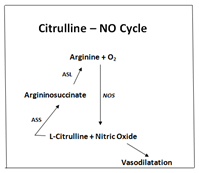
Additionally, amino acids such as Glutamate, Proline, etc., act as precursors of Citrulline. Intestinal epithelium converts Glutamate to Citrulline via the enzyme glutamate-5-semialdehyde, releasing carbamoyl phosphate as an intermediate. 6
In plants, citrulline is a by-product of the arginine biosynthetic pathway. It is synthesized in the chloroplast using ornithine as a precursor, and the reaction is catalyzed by the enzyme Ornithine transcarbamylase (OTC). 7

2. Ornithine â€" Ornithine is another NPAA produced as a metabolic by-product of the urea cycle. The body can produced ornithine on its own. Hence a deficiency of this amino acid is rare. The main sources of L-ornithine are chocolate, coconut, gelatin, meats, oats, soybeans, wheat germ, etc. 8
In the urea cycle, ornithine is synthesized from arginine with the help of the enzyme Arginase 1. Urea is released as a by-product which further continues the cycle. Hence ornithine can be regarded as the central molecule of the urea cycle. 9
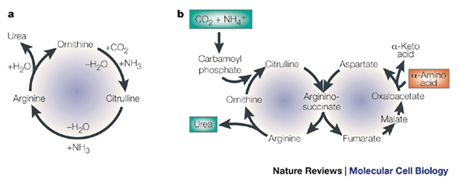
In plants, ornithine is synthesized in the mitochondrion after arginine gets transported from the cytosol into the mitochondrion. This reaction is catalyzed by the enzyme Arginase. 10
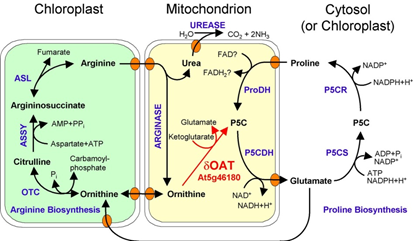
3. Theanine â€" This amino acid is also known as N5-ethyl-L-glutamine. It is found in plants and fungi. This amino acid is known as ‘theanine’ as it was first discovered in green tea. The main sources of theanine are green tea, black tea, Japonica, etc. 11
In plants, biosynthesis of theanine takes place using L-glutamic acid as a precursor with glutaminase as the enzyme catalyzing the reaction. Ethylamine releases ammonia as a result of the reaction. 12
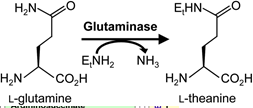
4. Trimethyglycine â€" Amino acid derivative first isolated from sugar beets. It is a trimethylated amino acid (glycine) which exists in the zwitterionic form at neutral pH. The main sources of trimethyglycine are beets, spinach, broccoli, shellfish, and whole grains. 13
In the body, synthesis of trimethylglycine takes place by oxidation reaction of choline and associated compounds. Choline upon oxidation produces betaine aldehyde with the help of the enzyme mitochondrial choline oxidase (choline dehydrogenase) in animals, choline monooxygenase in plants, and choline oxidase in bacteria. Further oxidation in the mitochondria results in the formation of trimethylglycine. This reaction is catalyzed by an NAD+ - dependent betaine aldehyde dehydrogenase enzyme. 14
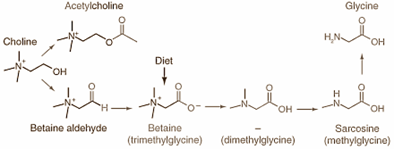
5. Taurine â€" Taurine is a by-product of methionine and cysteine. But, taurine does not contain a carboxylic acid group. Therefore, it is an amino sulphonic acid. Taurine was first isolated from ox bile ("taurus") hence the name. The main sources of taurine are animal and fish protein, animal meat, eggs, brewer’s yeast, etc. 16
In mammals, biosynthesis of taurine takes place via the cysteine sulfinic acid pathway. The enzyme cysteine dioxygenase oxidizes thiol group of cysteine to form sulfinic acid. Sulfinic acid undergoes decarboxylation with the help of sulfoalanine decarboxylase to form hypotaurine. Hypotaurine further undergoes enzymatic dehydrogenation (hypotaurine dehydrogenase) to form Taurine. 17
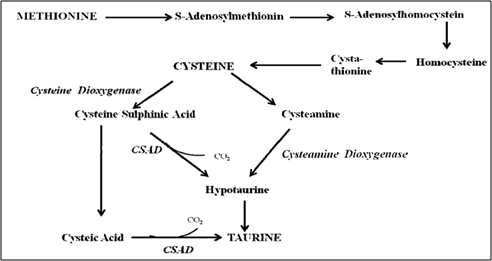
Significance
The significance of the above-mentioned NPAAs is as follows â€"
1. Citrulline â€" Citrulline is one of the amino acids recommended for therapeutics against erectile dysfunction. 19
Enzymes such as peptidylarginine deiminases convert arginine to citrulline. This citrulline is added on to some proteins during post-translational modification. Some of the proteins include myelin basic protein, filaggrin, histone proteins, etc. 20
Detection of antibodies bound to citrulline can be regarded as a biomarker for the detection of rheumatoid arthritis. 20
Citrulline has been found to protect muscle function during conditions of dietary restriction. 20
2. Ornithine â€" Ornithine is the precursor molecule of the amino acids citrulline, glutamic acid, and proline. 21
Ornithine also acts as a detoxification agent in the liver, reducing liver cirrhosis as well as other liver disorders. 21
Ornithine has also been to observe to reduce ammonia concentrations in the bloodstream. 21
3. Theanine â€" Dietary supplements containing theanine have been found to act as a relaxant and aid in stress reduction by altering levels of various neurotransmitters in the brain. Theanine possesses the ability to cross the blood brain barrier. 22
Theanine has also found to support the immune system by increasing the production of T lymphocytes. 23
4. Trimethyglycine â€" It can donate three methyl groups, which can be extremely useful in biochemical reactions. 24
Trimethylglycine works alongwith B-complex vitamins â€" Vitamin B6, Folic acid, Vitamin B12 - so as to assist in the formation of SAM (s-adenosyl methionine), an amino acid required for the brain. SAM also functions as an antidepressant in the brain. 25
Trimethylglycine also plays a role in the synthesis of carnitine which protects against kidney disorders. 26
Trimethylglycine has been used as therapy against the following health conditions â€" 27
- Hepatitis and Non-Alcoholic Steatohepatitis
- High Homocysteine
- Atherosclerosis
5. Taurine â€" Taurine helps lower cortisol levels as it controls anxiety and stress levels. It improves reaction time in athletes, thereby improving athletic performance. 28
Taurine also prevents diabetes by controlling insulin levels, as well as helps fight inflammation. Taurine also possesses the property of lowering lipid levels from the blood stream, which protects against cardiovascular disorders and helps reduce cholesterol. 28
Taurine also helps protect the liver against oxygen free-radicals. 29
In felines, taurine is required for proper development of retina. Hence feline meals should either contain fish protein (rich in taurine) or artificially enriched with taurine (cat food). Taurine deficiency in felines leads to degeneration of retina resulting in blindness, as well as loss of fur. 30
References
1. Non-proteinogenic amino acid. Available from http://www.ebi.ac.uk/chebi/searchId.do?chebiId=CHEBI:83820 (Accessed on May 27, 2016)
2. Non-proteinogenic amino acids – Wikipedia, The Free encyclopedia. Available from https://en.wikipedia.org/wiki/Non-proteinogenic_amino_acids (Accessed on May 27, 2016)
3. D’Mello JPF. Toxicity of non-protein amino acids from plants. Available from https://www.google.co.in/search?tbm=bks&hl=en&q=Amino+Acids+and+Their+Derivatives+in+Higher+Plants (Accessed on May 27, 2016)
4. Citrulline – Wikipedia, The Free Encyclopedia. Available from https://en.wikipedia.org/wiki/Citrulline (Accessed on May 27, 2016)
5. CasePerformance: Nitric Oxide. Available from http://www.caseperformance.com/126/nitric-oxide-supp-s-part-i-understanding-the-key-players (Accessed on May 27, 2016)
6. PathwayCommons::Citrulline Biosynthesis. Available from http://www.pathwaycommons.org/pc/record2.do?id=505647 (Accessed on May 27, 2016)
7. Winter G, Todd CD, Trovato M, Forlani G and Funck D. Physiological implications of arginine metabolism in plants. Front. Plant Sci. 2015;6:534. doi: 10.3389/fpls.2015.00534
8. Bliss Returned. Ornithine: The amino acid that helps to prompt the release of growth hormone, which promotes the metabolism of excess body fat. Available from https://blissreturned.wordpress.com/2012/03/26/ornithine-the-amino-acid-that-helps-to-prompt-the-release-of-growth-hormone-which-promotes-the-metabolism-of-excess-body-fat/ (Accessed on May 27, 2016)
9. The Ornithine Cycle. Available from http://www.nature.com/nrm/journal/v1/n3/fig_tab/nrm1200_225a_F2.html (Accessed on May 27, 2016)
10. Funck D, Stadelhofer B, Koch W. Ornithine-δ-aminotransferase is essential for Arginine Catabolism but not for Proline Biosynthesis. BMC Plant Biology. 2008;8:40. doi:10.1186/1471-2229-8-40
11. Theanine. Available from https://examine.com/supplements/theanine/ (Accessed on May 27, 2016)
12. L-Theanine synthesis. Available from http://pubs.rsc.org/services/images/RSCpubs.ePlatform.Service.FreeContent.ImageService.svc/ImageService/Articleimage/2014/RA/c3ra45315d/c3ra45315d-s1_hi-res.gif (Accessed on May 27, 2016)
13. Trimethylglycine. Available from https://examine.com/supplements/trimethylglycine/ (Accessed on May 27, 2016)
14. Choline and Betaine Uptake and Betaine Biosynthesis. Available from http://www.phantome.org/PhageSeed/SubsysEditor.cgi?page=ShowSubsystem&subsystem=Choline_and_Betaine_Uptake_and_Betaine_Biosynthesis (Accessed on May 27, 2016)
15. Alpha-GPC gave man (79) uncontrollable libido. Available from http://www.ergo-log.com/alpha-gpc-gave-man-79-uncontrollable-libido.html (Accessed on May 27, 2016)
16. What is Taurine Derived From? Available from http://www.whathealth.com/taurine/overview.html (Accessed on May 27, 2016)
17. Taurine – Wikipedia, The Free encyclopedia. Available from https://en.wikipedia.org/wiki/Taurine#Biosynthesis (Accessed on May 27, 2016)
18. Menzie J, Prentice H, Wu J-Y. Neuroprotective Mechanisms of Taurine against Ischemic Stroke. Brain Sciences. 2013;3(2):877-907. doi:10.3390/brainsci3020877
19. Erectile Dysfunction and L-Citrulline. Available from http://www.healthline.com/health/erectile-dysfunction/l-citrulline (Accessed on May 27, 2016)
20. Citrulline – Wikipedia, The Free Encyclopedia. Available from https://en.wikipedia.org/wiki/Citrulline#Function (Accessed on May 28, 2016)
21. The Amino Acid Ornithine. Available from http://www.vitaminstuff.com/amino-acid-ornithine.html (Accessed on May 28, 2016)
22. L-Theanine - Sex Drive Support / Dopamine / Glutamate. Available from http://www.smartbodyz.com/L-Theanine-Information.htm (Accessed on May 28, 2016)
23. Bukowski JF, Percival SS. L-theanine intervention enhances human γδ T lymphocyte function. Nutrition Reviews. 2008;66(2):96-102. doi: 10.1111/j.1753-4887.2007.00013.x
24. Trimethylglycine or TMG. Available from http://drlwilson.com/Articles/TRIMTHYLGLYCINE.htm (Accessed on May 28, 2016)
25. TMG (Trimethylglycine). Available from https://www.solal.co.za/tmg (Accessed on May 28, 2016)
26. Trimethyglycine (TMG, Betaine) Powder. Available from http://www.nutrabio.com/Products/trimethylglycine.htm (Accessed on May 28, 2016)
27. Betaine (Trimethylglycine). Available from http://www.mottchildren.org/health-library/hn-2807004 (Accessed on May 28, 2016)
28. Ten Benefits of Taurine. Available from http://main.poliquingroup.com/ArticlesMultimedia/Articles/Article/782/Ten_Benefits_of_Taurine.aspx (Accessed on May 28, 2016)
29. ZHANG Z, LIU D, YI B, et al. Taurine supplementation reduces oxidative stress and protects the liver in an iron-overload murine model. Molecular Medicine Reports. 2014;10(5):2255-2262. doi:10.3892/mmr.2014.2544
30. Taurine – Wikipedia, The Free Encyclopedia. Available from https://en.wikipedia.org/wiki/Taurine#In_animal_nutrition (Accessed on May 28, 2016)
About Author / Additional Info:
I am a post-graduate in Biochemistry from the University of Mumbai